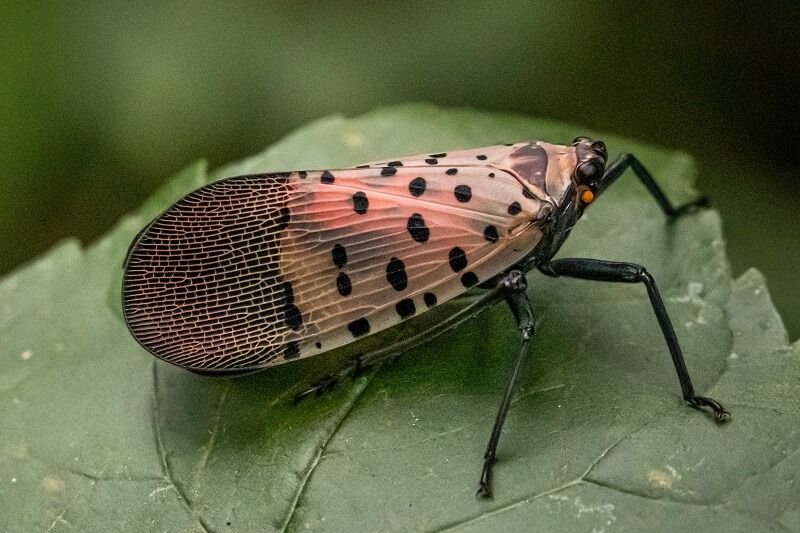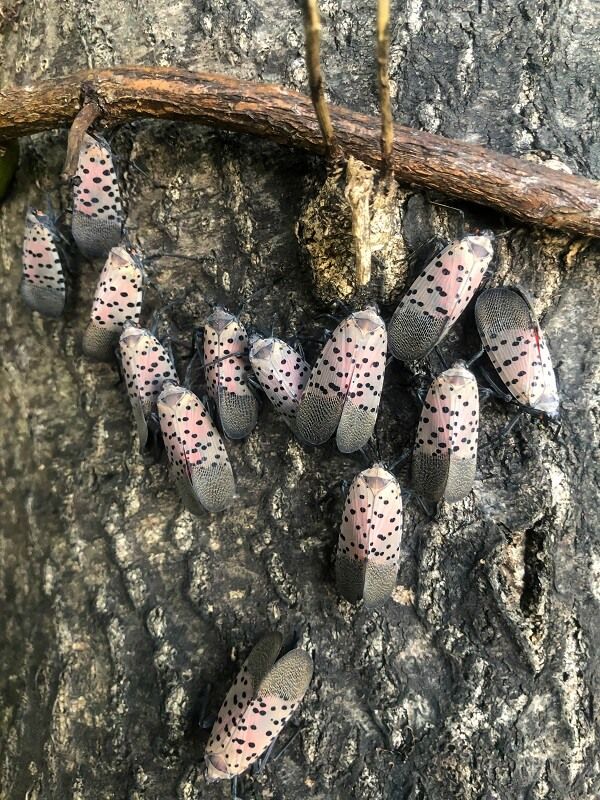What You Need To Know About the Spotted Lanternfly
What is the spotted lanternfly? If you live in Pennsylvania, you have probably already seen this insect. The spotted lanternfly (lycorma delicatula or SLF) is an invasive species native to China and Southeast Asia.
The pest was discovered in Pennsylvania in 2014, specifically Berks County, and has spread throughout Pennsylvania and neighboring states: north to Massachusetts, south to North Carolina, and west to Indiana and Michigan (See the Spotted Lanternfly distribution map for the mid-Atlantic area). The spotted lanternfly feeds on and damages many different plant species.
Many homeowners have reported sightings and damage from this pest, both direct damage by feeding and secondary damage due to excessive sooty mold formation on lanternfly excrement (honeydew). As part of our series on invasive insects, here is what you need to know and what you can do if you spot the colorful insect around your property.
What You Need to Know About the Spotted Lanternfly
As of 2023, the spotted lanternfly is reported to be found in 51 Pennsylvania counties and can build to astounding numbers when left unmanaged. While many Pennsylvania residents have spotted this invasive species on their landscapes, we have some information to help those who want to keep their landscape free from invasive insects.
Appearance
Adult spotted lanternflies can be identified by their coloration and bodies. The insect has grayish wings with black spots; the tips are black and gray, while the bodies are black. When flying, spotted lanternflies will show vibrant red hind wings. Adults are around 1 inch long and a half-inch wide with wings folded. They can jump several feet when startled or approached.
You can also identify the pest via their egg masses or nymph stage. Egg masses are typically found on tree bark on the underside of scaffold branches and occasionally on other smooth surfaces such as rocks, outdoor furniture, and even vehicles. The mass is usually around 1 inch long and a half to three-quarters of an inch wide, with a gray-brown, mud-like covering.
Spotted lanternfly nymphs are much smaller than adults, only about 1/8 to 1/2 an inch long (depending on instar: a phase between two periods of molting in the development of an insect larva or other invertebrate). However, nymphs have distinct coloration: initially black with white spots and wingless, developing red patches/red patches and white spots as they mature.


Behavior & Problems
Spotted lanternflies feed on plant sap, and at a high population, this can cause significant damage to an area’s plant life. While known to feed on over 70 different plants, spotted lanternflies have strongly preferred the tree of heaven (ailanthus altissima), grapevines, maple trees, black walnut, birch, willow, and styrax.
Feeding on tree and plant sap can cause wilting, leaf curling, and dieback. In addition, as the SLF feeds on plant sap, the insect excretes a sugary substance called “honeydew,” which can attract bees, wasps, and other insects, and promotes the growth of sooty mold, which causes further damage to plants.
Here are the months each life stage occurs to help you better identify the plant pest on your property.
Egg masses: The invasive pest usually lays eggs from September to November, and lanternflies spend the winter as eggs.
Nymphs: Nymphs will first hatch around May to June and mature until around July to September.
Adults: July to September is when most spotted lanternflies have matured into adults; mating and egg-laying can continue until December.
The insect has become so prevalent that Pennsylvania has put affected counties under quarantine to stop the movement and slow the insect’s spread to new areas within or out of the current quarantine zone. The quarantine involves traveling and transporting outdoor items.
What You Can Do
If you see any spotted lanternfly or signs of its damage on your property, contact Burkholder Plant Health
Care (PHC). Burkholder PHC treats for spotted lanternflies as part of our plant health care program. Our plant health care program emphasizes proper diagnosis and precise treatment, using only state-of-the-art, research-backed methods and equipment. We also utilize various pest management and control processes to protect your landscape from invasive, harmful pests.
Additional Spotted Lanternfly Resources
For more information about spotted lanternfly issues in Pennsylvania, you may wish to visit the following resource links.
Cooperative State Program Homepage
Cooperative State Program Map
Pennsylvania Quarantine Details/Updates
Pennsylvania Quarantine Map
Mid-Atlantic SLF Distribution Map
Contact Burkholder Brothers for Plant Health Care Services
If you want to keep your landscape beautiful, healthy, and free of spotted lanternfly, contact Burkholder PHC for a consultation. Our team of plant health care professionals has decades of experience helping homeowners keep their landscapes as healthy and vibrant as possible. In addition, we have up-to-date knowledge of the latest plant health care methods, from pest control to soil care and more. For more information on our services, contact us today.

